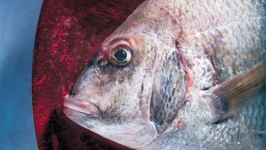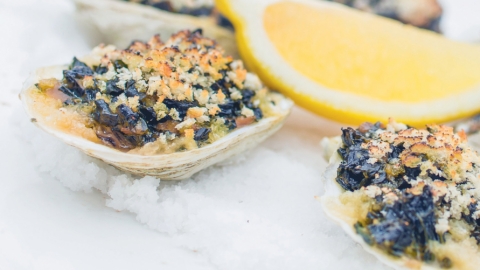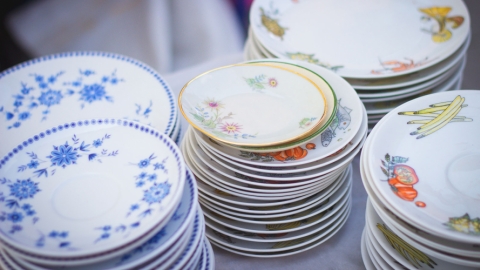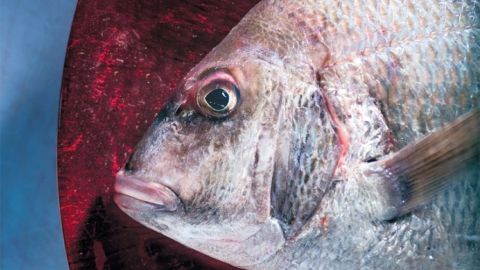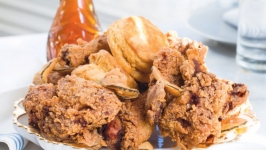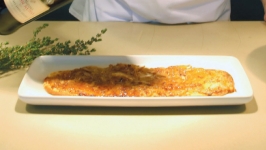The Diving Horse: Baked Oysters
CHEF: John Boswell
RESTAURANT: The Diving Horse
LOCATION: Avalon
A quick Google search for the term “Oysters Rockefeller” yields almost half a million results revealing countless variations on this intensely rich pre-dinner treat. John Boswell, executive chef at The Diving Horse in Avalon, has his own ever-evolving version, which he changes with the seasonal progression of local produce. Boswell’s original version of baked oysters, however, sprang from his cooking style, which focuses on making maximum use of what’s on hand.
“As a chef, you don’t want to waste anything,” Boswell says. “I had this filling for a whole stuffed fish made with seasonal produce. I think it was fennel that we had cooked down and added cream to. Something clicked in my head—if we use it as a filling for a fish, why wouldn’t we use it as a filling for oysters?”
Boswell’s baked oysters begin with seasonal greens that are cooked down slowly along with thinly sliced onion and garlic. After cooling, the greens are chopped up fine so they retain a bit of texture. Boswell cautions not to over-season the greens as they cook, as the dish also contains anchovies and oysters, which both add salt.
Bagna cauda, a classic Italian dip for fresh vegetables, is then folded into the greens, adding a delicious creamy seasoning of garlic and anchovy. “There are lots of different ways to make bagna cauda— some emulsified and some not,” Boswell says. “For this recipe, it’s definitely got to be a creamy, emulsified version.” He learned this preparation while working for Marc Vetri, chef and founder of a family of critically acclaimed restaurants in Philadelphia. Here, the garlic and anchovies are confited in warm olive oil and then pureed in a blender while gradually adding hot cream. If you add the cream correctly, Boswell says, the mixture will end up thick and creamy.
The greens mixture is spooned on top of oysters, which can be opened by placing them in a warm oven for a few minutes. This process is easier for home cooks who are unfamiliar with shucking oysters and helps retain the oysters’ juices. The oysters are then topped with coarse, lightly toasted breadcrumbs and baked for a few minutes until the filling is heated through and the breadcrumbs form a nice crust.
“I love Cape May oysters, because the one thing that I do think rings true about oysters is that they taste like the waters that they come from. When I taste a Cape May salt oyster, that’s the flavor of diving in the ocean for me.” —Chef John Boswell, The Diving Horse
Boswell prefers a medium-size oyster for this recipe, relying on suppliers such as Mike Kenlay at Local 130 to tell him which variety is best at that moment. “It’s always a conversation with Mike—him being a really good purveyor for us because he lets us know what’s best, what’s in season,” Boswell says. “For me as a chef, not just in this dish specifically, but really for anything, it is important to just buy the best ingredients that [I] can. I’m sure some chefs who serve Oysters Rockefeller might say you should have a really salty oyster or you should have a milder oyster. For me, it is more ‘What oysters can I get that I really like and I think are really delicious?’”
Boswell also questions the seasonal edicts around oysters. “A lot of people talk about how oysters are best in the winter. I kind of disagree,” Boswell says. “I love Cape May oysters, because the one thing that I do think rings true about oysters is that they taste like the waters that they come from. When I taste a Cape May salt oyster, that’s the flavor of diving in the ocean for me.”
The beauty of Boswell’s baked oysters, which he describes as “summer in a bite,” is that any seasonal greens can be used. He’s even planning to test a filling of mixed local red peppers and onions in late summer. “The inception of the dish—where it all started from—was using what we had,” Boswell says. “I know a lot of people see recipes and they go out and buy specifically for that recipe. But, if you’re a fairly competent cook, you really could make it with whatever you want to put in there.”
If you want to save on washing up time, he even suggests skipping the bagna cauda and just adding anchovies and extra garlic into the olive oil when cooking the greens, then adding some cream at the end. Boswell, however, prefers to make the greens and bagna cauda separately so he can maximize the flavor of each.
“I like having my components separate so I can take my time to make each individual component really good and then mix it together,” Boswell says. “This is the most delicious way I can make it, so why wouldn’t I do that?”
As to the future evolution of this dish, Boswell notes, “That’s just my recipe for [baked oysters] at this time and moment in my life. I’m sure it will evolve in a bit of a different way throughout the summer—and in my life in general. It is definitely something that I will keep bringing with me in my journey as a cook.”
THE DIVING HORSE
2109 Dune Dr., Avalon
609.368.5000
thedivinghorseavalon.com





